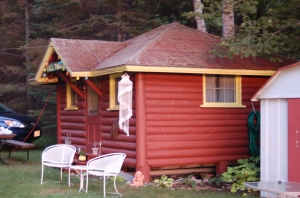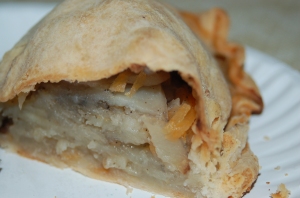This summer, the whole family took what is becoming a regular pilgrimage to the Upper Peninsula of Michigan to visit my man Dave’s family on the maternal side. I call it a pilgrimage because it takes 22 hours to get there by car, which deserves it’s very own blog entry!
There is no place on earth I can compare it too. It feels wildly remote and the coniferred land stretches out until it hits the biggest lakes in the United States: Lake Superior, Lake Michigan, Lake Huron, as well as the St Lawrence river. That’s a lot of water!
Large numbers of Finnish, Swedish, Danish and Norwegian immigrants came to the Upper Peninsula, mainly to work in the copper mines, which were booming between 1890 to the 1920’s. Towns grew where miners prospered, and some of these towns were breathtaking, like Calumet, full of beautiful mansions, churches, and an impressive theater, which incidentally was built with the then prosperous town’s enormous surplus treasury.
When the heyday of copper mining came to a close and people drifted away to find work, these towns all but died. Whole streets of beautiful houses were abandoned and left to the ravages of cruel northern winters.
Walking through towns that were at the center of the industry like Calumet (previously called Red Jacket) and Laurium, it is easy to imagine how life in the early 20th century might have been amazing if you came from a wealthy mining family. You would have lived in a sprawling castle of a place, possibly attending church at St Joseph’s catholic church which was built with local sandstone and looked more like a cathedral from old Europe than a church for a mining community in the United States. There was also shopping and live theatre; quite the life.
So many of these buildings today are in dire needed of conservation, and, if you decide to become a writer or artist, and need a cheap place to live, you can buy one for a song.
My reason for this very brief history is to be able to tell you about the Pasty, which also came to the upper Peninsula at this time and was synonymous with miners.
From what I can gather, when tin mining dried up in Cornwall, England, a good portion of them travelled to the Upper Peninsula, namely The Keweenaw Peninsula and Houghton, to work the copper mines, which was the largest supplier of copper in its day (late 19th, early 20th century).
They brought their family with them, and, what do you think the women gave them in their lunch pails? The same thing they gave them in the old country; a hefty pasty! That pasty had everything to sustain a miner working a twelve-hour day; meat, bread and potatoes.
What is a pasty? This could spur an argument depending on where you come from, but I am going to stick with the pasty found in the Upper Peninsula which touts to be identical to the Cornish Pasty from England. I wanted to find out if this was actually true…
In short it is a dough filled with potatoes, onions and beef. This is a very loose description, and, my mission was to find a very specific recipe.
It was harder to find out than you would think. Looking through all the local cookbooks only told me of the claim. When I asked people I just got vague answers saying yes, this pasty came from England, and is definitely the real deal.
Generally, everyone seemed to agree on potatoes, onions, and/or rutabaga (rutabaga is turnip, for all intents and purposes. It is sometimes called swede where I come from, which makes sense as it is said to have come form Sweden in the 18th century).
I decided the only way to find my answer was to compare the two pasties. I scoured the books shops looking for something other than a local cookbook, which just had a recipe and a reference to the origin. I needed someone in Cornwall to make the connection?
As luck with have it I cam across a very slim little volume while in Calumet, called The Pasty Book, by Hettie Merrick who was born and bred in Cornwall. The book was published in Cornwall so I figured it would tell me what I needed to know.
It turned out to be a fantastic book written by a woman who lived and breathed Pasties! She grew up on them, ran a Pasty Shop and gave all sorts of details about how the pasty came about.
The best bit was when she talked about the miners and how they lived on these pies, and how mine owners provided their workers with large ovens at the surface specially to keep the pasties warm until lunch time.
When they went abroad, they took the recipe with them. She referred to various places in the world where the pasty tradition from Cornwall is alive and well, and, you guessed it, one of her references was to the mining country of Michigan!
Now I was convinced that the pasty from the U.P was the genuine article. I suppose I would have to go to Cornwall to complete my experiment, but for now I was satisfied with my little pasty book with its lore and recipes, and to have a pasty while on my stay on Bootjack road, just outside of Lake Linden.
To try the typical pasty from the area, I would have to get it from the most popular place for miles around; Toni’s Country Kitchen in Laurium, right in the heart of old Copper Country.
Every year when we make the trip and stay at Aunt Sue’s beautiful Cabin on Torch Lake, it is a custom that one of the nights we have pasties for dinner. They are so popular, you have to preorder in the morning, and pick up no later than 5pm, or you are out of luck.
Aunt Sue and Diane (my mother-in-law: don’t panic, she is lovely) picked the pasties up from Toni’s, as we were off at some beach or other scouring for agates, and when we arrived home, the pasties were waiting. I cut one open and immediately investigated.
It was very close to perfection. The dough was thick without being gummy, and the filling was cooked perfectly, moist with not a hint of sogginess.
The potatoes were sliced very thin and meat was present, but not overly abundant. It was easy to pick up and eat like a sandwich, holding together until the last bite.
The Cornish pasty is always filled with raw ingredients, and cooked at the same time as the dough. It takes about 45 to 50 minutes to cook a pasty in a hot oven. The pasty from Toni’s used this method.
We will be back next year for my man Dave’s grandmother’s 100th birthday!
We will hang out on Torch Lake with Aunt Sue, Diane and all of her other siblings, and their children. We will hunt for agates on the countless beaches, go for lunch to the Keweenaw Lodge in Copper Harbor, and go out on Uncle Ron’s boat to try our luck at catching dinner.
And we will of course, have pasties one night for dinner.


















